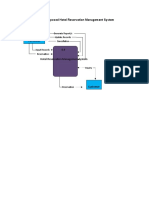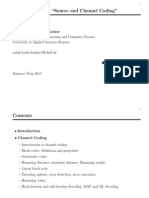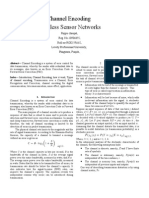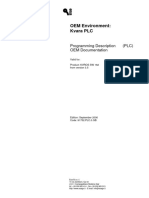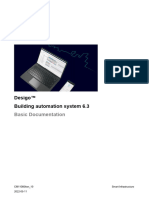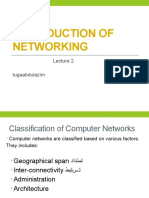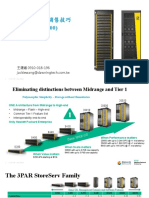Channel Coding 2
Uploaded by
Mostafa ElsherbiniChannel Coding 2
Uploaded by
Mostafa ElsherbiniChannel Coding
Dr. Varun Kumar
Dr. Varun Kumar (IIIT Surat) Channel Coding 1 / 12
Outlines
1 Introduction to Encoding
2 Channel Coding
3 Conclusion
4 References
Dr. Varun Kumar (IIIT Surat) Channel Coding 2 / 12
Introduction to Encoding
During conversion of analog signal into digital, following steps are taken
1 Sampling
2 Quantization
3 Encoding
Encoding is further classified into three sections.
Source Coding −→ Bandwidth suppression, Decrease in redundancy,
Removal of extra bit (Data compression−→ Lossless & Lossy
Compression).
Different Technique for Source Coding:
i. Huffman Code (Application–JPEG, MPEG, MP3)
ii. Fano Code
iii. Shannon Code
iv. Arithmetic Code
Dr. Varun Kumar (IIIT Surat) Channel Coding 3 / 12
Channel Coding[1],[2]
The key to achieving error free digital communication in the presence of
distortion, noise, and interference is the addition of appropriate
redundancy to the original data bits.
Channel Coding
It is used for error correction and detection of bit stream, which is sent
from the information sink.
For error correction and detection, extra/redundant bits (parity bits)
are added into bit stream.
Due to more (redundant+information) bits, bit error rate (BER) is also
more during channel encoding.
Due to more (redundant+information) bits transmission from
information sink causes loss in spectral efficiency or we enhance error
correction and detection capability at the cost of sacrifice of bandwidth.
Dr. Varun Kumar (IIIT Surat) Channel Coding 4 / 12
Continued–
Types of Channel Coding:
i. Linear block codes
Cyclic codes (e.g., Hamming codes)
Turbo codes
Polynomial codes (e.g., BCH codes)
ReedSolomon codes
Algebraic geometric codes
ii. Convolution codes
Low Density Parity Check (LDPC) code
Forward Error Correction (FEC):
i. Block Codes
In Linear block codes, every block of k data digits is encoded into a
longer codeword of n digits (n > k).
In block codes, k data digits are accumulated and then encoded into
n-digit codeword.
Dr. Varun Kumar (IIIT Surat) Channel Coding 5 / 12
Continued–
ii. Convolution codes
In convolution codes, the coded sequence of n digits not only
depends on the k data digits, but also on the previous N − 1 data
digits (N − 1). In short encoder has a memory.
Redundancy for Error Correction:
In FEC codes, a codeword is a unit of bits that can be decoded
independently.
The number of bits in codeword is known as code length.
If k data digits are transmitted by a codeword of n digit (n > k), then
number of check bit m = n − k.
k
Code-rate = n . Code is known as (n, k).
dmin is the minimum distance between t error correcting codewords
without overlapping, is
dmin = 2t + 1 (1)
Dr. Varun Kumar (IIIT Surat) Channel Coding 6 / 12
Continued–
n k Code Code rate
Single error correcting, t=1 or dmin =3 3 1 (3,1) 0.33
4 1 (4,1) 0.25
15 11 (15,11) 0.73
Double-error correcting, t=2 or dmin =5 10 4 (10,4) 0.4
15 8 (15,8) 0.533
Triple error correcting, t=3 or dmin =7 10 2 (10,2) 0.2
Table: Some example of error correcting codes
−→ The minimum distance between t error detecting codewords is
dmin = t + 1 (2)
Dr. Varun Kumar (IIIT Surat) Channel Coding 7 / 12
Linear Block Codes:
c = dG (3)
where, c = Codeword vector (1 × n)
d = Data or information vector (1 × k)
G = Generator Matrix (k × n)
Generator matrix G = [Ik P], where P −→ k × m matrix, m = n − k
c =dG
=d[Ik P]
(4)
=[d dP]
=[d cp ]
Hamming distance between two codeword ca and cb is
d(ca cb ) = weight of (ca ⊕ cb ) (5)
Dr. Varun Kumar (IIIT Surat) Channel Coding 8 / 12
Continued–
Figure: Information processing across transmitter end
Line Coding −→ It is a process through which bit stream is
converted into electrical pulse.
Different Technique for Line Coding:
i. NRZ
ii. RZ
iii. Manchester
iv. AMI
v. Bipolar etc
Dr. Varun Kumar (IIIT Surat) Channel Coding 9 / 12
Conclusion
Channel encoding ensure that how can we detect and correct the
error in information bit stream.
Linear block code and convolution code are two types through which
we do the channel coding.
Greater the redundancy lesser be code efficiency.
Dr. Varun Kumar (IIIT Surat) Channel Coding 10 / 12
References
B. P. Lathi, Z. Ding et al., “Modern Digital and Analog Communication Systems /
BP Lathi, Zhi Ding.” 2010.
M. Borda, Fundamentals in information theory and coding. Springer Science &
Business Media, 2011.
Dr. Varun Kumar (IIIT Surat) Channel Coding 11 / 12
Thank You
Dr. Varun Kumar (IIIT Surat) Channel Coding 12 / 12
You might also like
- Information Theory, Coding and Cryptography Unit-3 by Arun Pratap Singh50% (4)Information Theory, Coding and Cryptography Unit-3 by Arun Pratap Singh64 pages
- Context Diagram of Proposed Hotel Reservation Management System67% (3)Context Diagram of Proposed Hotel Reservation Management System8 pages
- Lecture Notes On "Source and Channel Coding"No ratings yetLecture Notes On "Source and Channel Coding"107 pages
- ECE4007 Information Theory and Coding: DR - Sangeetha R.GNo ratings yetECE4007 Information Theory and Coding: DR - Sangeetha R.G24 pages
- 5CS3-01: Information Theory & Coding: Unit-3 Linear Block CodeNo ratings yet5CS3-01: Information Theory & Coding: Unit-3 Linear Block Code75 pages
- 3F4 Error Control Coding: Dr. I. J. WassellNo ratings yet3F4 Error Control Coding: Dr. I. J. Wassell70 pages
- Forkan EEE 520 3 Coding and Coded ModulationNo ratings yetForkan EEE 520 3 Coding and Coded Modulation28 pages
- Channel Coding: (Coding Concepts and Linear Block Codes)No ratings yetChannel Coding: (Coding Concepts and Linear Block Codes)14 pages
- Coding in Communication System: Channel Coding) Will Be AddressedNo ratings yetCoding in Communication System: Channel Coding) Will Be Addressed5 pages
- Chapter-4: Error Control Coding: (Digital Communication)No ratings yetChapter-4: Error Control Coding: (Digital Communication)35 pages
- DC Digital Communication MODULE IV PART2No ratings yetDC Digital Communication MODULE IV PART2245 pages
- Diversity Technique For Mobile Radio SystemNo ratings yetDiversity Technique For Mobile Radio System28 pages
- Blind Identification of Convolutinal Codes Based On Veterbi AlgorithmNo ratings yetBlind Identification of Convolutinal Codes Based On Veterbi Algorithm4 pages
- Point-to-Point Wireless Communication (III) :: Coding Schemes, Adaptive Modulation/Coding, Hybrid ARQ/FECNo ratings yetPoint-to-Point Wireless Communication (III) :: Coding Schemes, Adaptive Modulation/Coding, Hybrid ARQ/FEC156 pages
- Chapter 3: Physical-Layer Transmission Techniques: Section 3.4: Channel CodingNo ratings yetChapter 3: Physical-Layer Transmission Techniques: Section 3.4: Channel Coding27 pages
- Introduction To Information Theory and Coding: Louis WehenkelNo ratings yetIntroduction To Information Theory and Coding: Louis Wehenkel34 pages
- Asst. Prof. Anindita Paul: Mintu Kumar Dutta Sudip Giri Saptarshi Ghosh Tanaka Sengupta Srijeeta Roy Utsabdeep RayNo ratings yetAsst. Prof. Anindita Paul: Mintu Kumar Dutta Sudip Giri Saptarshi Ghosh Tanaka Sengupta Srijeeta Roy Utsabdeep Ray38 pages
- Unit Iv Linear Block Codes: Channel EncoderNo ratings yetUnit Iv Linear Block Codes: Channel Encoder26 pages
- 155Mbps SFP Optical Transceiver, 20km Reach: AOP-303-R20 (D)No ratings yet155Mbps SFP Optical Transceiver, 20km Reach: AOP-303-R20 (D)9 pages
- Desigo Automation System With PLlink Device TableNo ratings yetDesigo Automation System With PLlink Device Table346 pages
- HPE - c04474811 - HP P6000 EVA Updating Product Software Guide (XCS 11300000)No ratings yetHPE - c04474811 - HP P6000 EVA Updating Product Software Guide (XCS 11300000)74 pages
- Step-by-Step Recovery Password For CISCO SwitchNo ratings yetStep-by-Step Recovery Password For CISCO Switch7 pages
- 10987C - Performance Tuning and Optimising SQL DatabasesNo ratings yet10987C - Performance Tuning and Optimising SQL Databases4 pages

